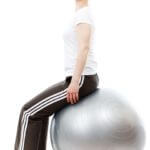FitBalls, or Gym balls/Swiss balls as they are also known, are most commonly used for exercises. They offer an unstable surface that can challenge your core muscles, making them ideal for targeted core strengthening routines.
But what  happens when you sit on them? Is it good to be sitting on something that is inherently unstable? Will sitting on a fitball strengthen your core?
happens when you sit on them? Is it good to be sitting on something that is inherently unstable? Will sitting on a fitball strengthen your core?
WorkCover QLD and Worksafe Victoria both advise that they are NOT suitable as office furniture, no doubt due to the increased risk of falling off and sustaining an injury!
HOWEVER, there are definitely some advantages to sitting on a fitball. Here are some of the potential benefits:
Fitball PROS:
- Fitballs are dynamic! Keeping a constantly moving platform whereby you experience small shifts and changes in your position (things like your weight distribution, pelvis and lower back positions are constantly adapting to stay balanced). This prevents your lower back from becoming too stiff, and can be great for pain relief from lower back pain.
- It’s harder to slouch. As there is no back-rest, the user of the FitBall is forced to recruit their own muscles to hold themselves upright. Note that it is more difficult, but not impossible, to slouch.
- It strengthens your core (maybe). This one is very dependent on how you sit on it. It will not miraculously strengthen your abdomen if you are not already used to engaging those muscles. Like any chair, it is only as good as how you use it. (ie. you can have the best chair in the world, but you can still find a way to slouch on it!). If you are used to engaging your core muscles, and you sit with a good posture on a fitball, then it will help your core strength and neuromuscular control.
- They come in different sizes! This might seem like an obvious one, but a lot of office chairs position the user so that their knees are higher than their hips. An ideal sitting position is one in which the hips are positioned slightly higher than the knees, which helps maintain a healthy lower back posture. Having a firm, inflated FitBall can help achieve this position.
Fitball CONS:
- They can roll away. When you stand up to go the printer, or replenish your coffee supply, the balls have a tendency to go wandering across the room, so you have to retrieve it before you can sit down again.
- They need re-inflating fairly regularly. To be most effective, the FitBalls do need to be kept fairly firmly inflated. With regular use, you may find the ball needs reinflating every few weeks (easily done with a substantial bike pump).
- You can fall off. If you tend to have poor balance or have a history of falls/clumsiness, perhaps FitBalls are not for you.
- They can burst. Depending on the quality, some FitBalls are more prone to punctures than others. In short, you get what you pay for. Higher quality balls are made of more durable material and are “burst-resistant”.
The bottom line is that FitBalls will not suit everybody, but for certain people they can make sitting at a desk a whole lot more comfortable. My advice would be that they are certainly appropriate for home use, but be careful with introducing them into a work environment due to the safety risks.
